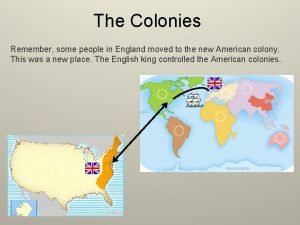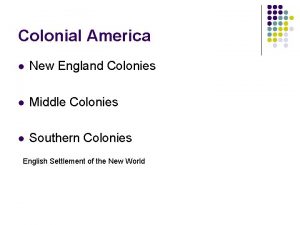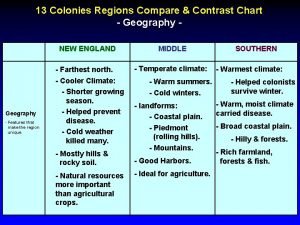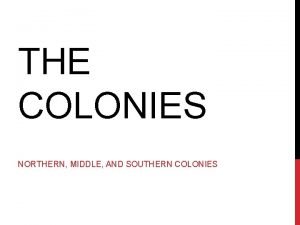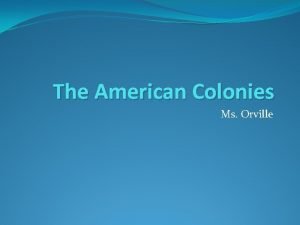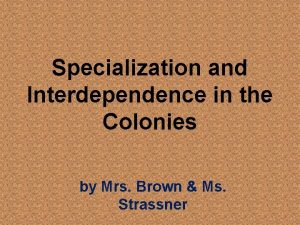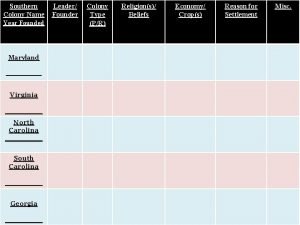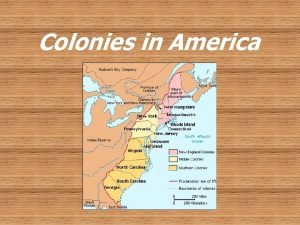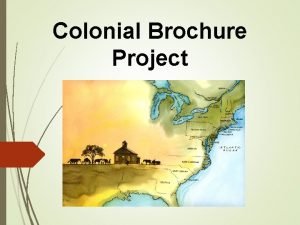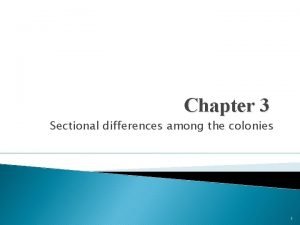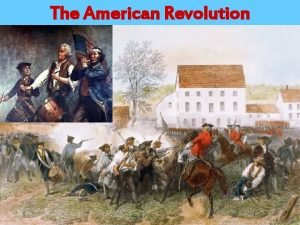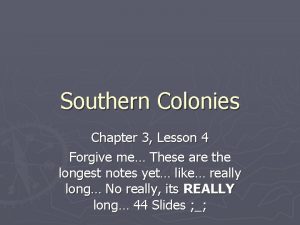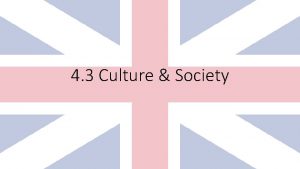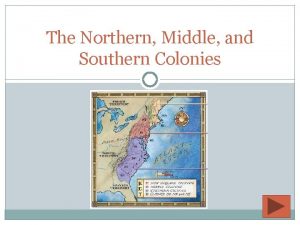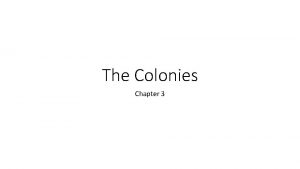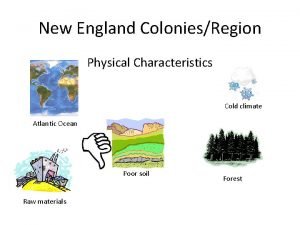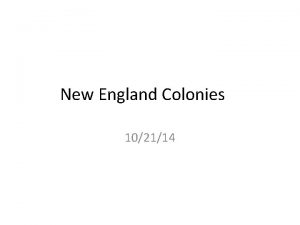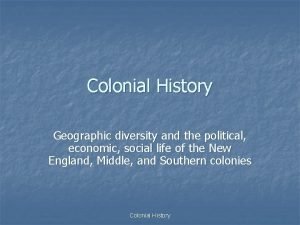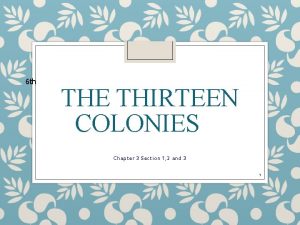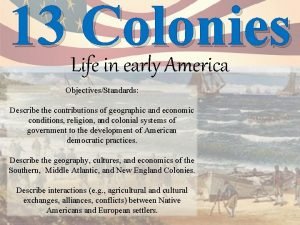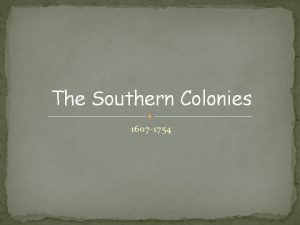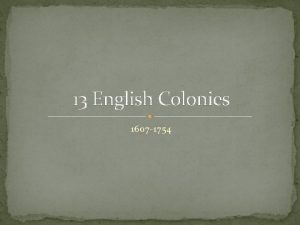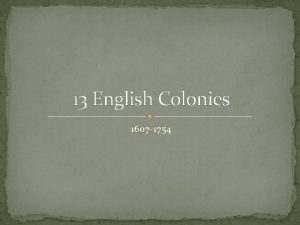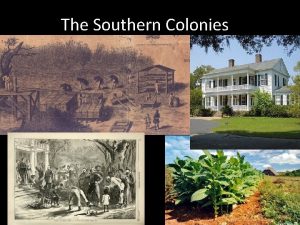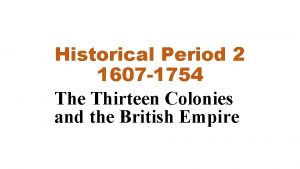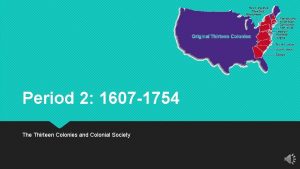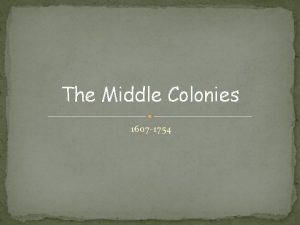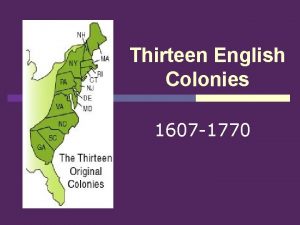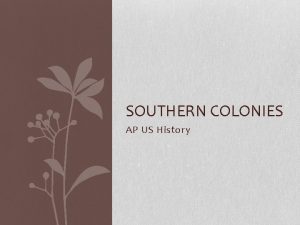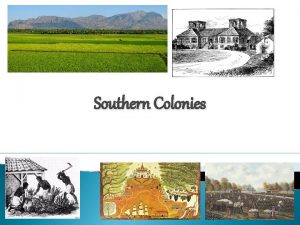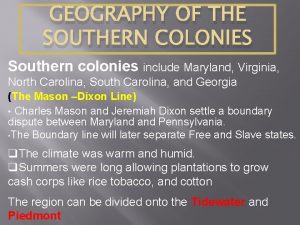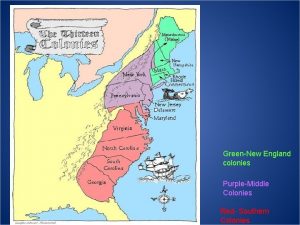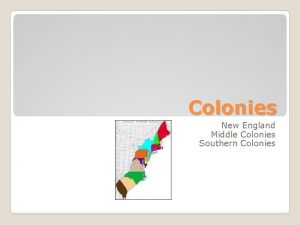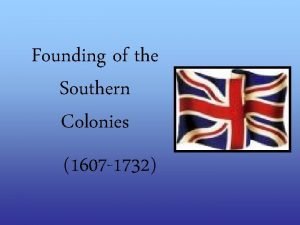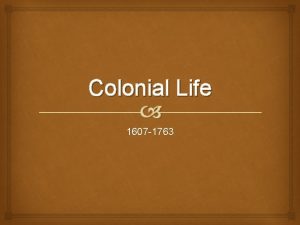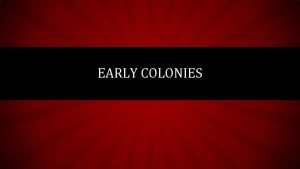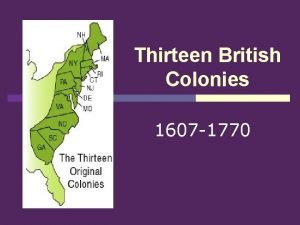13 English Colonies 1607 1754 The Southern Colonies



























- Slides: 27

13 English Colonies 1607 -1754

The Southern Colonies 1607 -1754

Key Concept 2. 1: Europeans developed a variety of colonization and migration patterns, influenced by different imperial goals, cultures, and the varied North American environments where they settled, and they competed with each other and American Indians for resources. �II. In the 17 th Century, early British colonies developed along the Atlantic coast, with regional differences that reflected various environmental, economic, cltral and demographic factors. � A) The Chesapeake and North Carolina colonies grew prosperous exporting tobacco-a labor-intensive product initially cultivated by white, mostly male indentured servants and later by enslaved Africans.


Why did so many colonists initially die in Jamestown?

The Lost Colony � A century after Columbus landed in the Caribbean, Europe’s seagoing nations were in full competition for the possible “riches” of the new world � England was latecomer to this race � Spain had already entered into what is now Florida and New Mexico � English pirates had been up and down the east coast of what is now the U. S. since 1562 � A colony was not seriously considered until 1578 when Sir Humphrey Gilbert received a charter from Queen Elizabeth “to inhabit and possess…all remote and heathen lands not in actual possession of any Christian prince” � After Gilbert died on his second voyage, Sir Walter Raleigh, his half-brother, decided to carry out the venture

The Lost Colony �England’s motives for settling the New World � Establish a base to loot French and Spanish shipping � Visions of gold and copper mines and cash crops � An attempt to find the Northwest Passage � Spread the new Protestant religion among the “savages”

The Lost Colony � 1584 -Philip Amadas and Arthur Barlowe � 1585 -Ralph Lane, Richard Grenville, Thomas Harriot, John White � 1586 -John White � 1590 -John White returns


Jamestown, Virginia 1607 �Early Virginians: � Gave America its first representative assembly (Virginia House of Burgesses) � Gave England a new vice—tobacco � Helped establish slavery as a labor system in the New World � 1 st 10 years of Jamestown colony 75, 000 British pounds spent to send 2000 settlers, but it was considered a disaster �Early accounts of Jamestown from Captain John Smith’s A Generall Historie of Virginia

Jamestown/Virginia � 1606 King James granted a charter to a group of London Merchants�London company was a joint-stock company by which investors could pool their resources to support the expedition �Investors hoped to find gold or silver, or a northwest passage to Asia �But after 4 months at sea only 105 of original 144 settlers reached Chesapeake Bay in 1607

Jamestown, Virginia �By the end of the first summer 46 more people died; only 38 survived by end of the year. �Theories as to why the colony had failed: 1. 2. 3. 4. 5. Colony’s original system of government (council of 13 men) had failed James River became contaminated every summer and produced dysentery, typhoid fever, malaria, Native Powhatan were unfriendly No one had planted enough corn (would rather negotiate or steal from natives) Colony had too many gentlemen who considered farming beneath them

Jamestown, Virginia � Colony suffered a setback in the winter of 1610 -”starving time” and an Indian war with the Powhatan � As the winter approached-hogs, hens, goats, sheep and horses were consumed � Turned to dogs, cats, rats � Some turned to boiling boot leather � On man killed, salted and ate parts of his wife � After 10 years, little had changed by 1617; New governor Samuel Argall arrived to find a “slum in the wilderness” � Argall noticed that the marketplace and the streets, and all the spare places were planted with tobacco. � Of the 2000 settlers sent since 1607 only 400 were alive

Jamestown, Virginia � Fortunes began to change when Sir Edwin Sandys was elected treasurer of the Virginia Company in 1618 � To attract more settlers and investors he offered land � “old planters” who had arrived before the spring of 1616 were granted 100 acres of land � Every new share purchased in the company would mean 100 more acres of land � Would give additional land if investors would pay the ship passage of tenant laborers; 50 acres for each new tenant � Became known as “headright” system (private property came to Virginia)

Jamestown, Virginia � Sandys worked to make the colony a more pleasant place to live � Instructed new governor, George Yeardly to create an assembly with power to make laws (laws would be binding as long as the company approved) � Each new settlement could send 2 representatives or burgesses (Virginia House of Burgesses) � 1 st convened in 1619 � No taxes required to pay for government officials salariespaid in land � From 1619 -1622, 3, 570 settlers were sent as part of Sandy’s program, by only 700 people remained. Records show that these people died. Why?

Jamestown, Virginia �Why were people dying at a time of increased immigration? � Men were sent unprepared (arrived with no food and found inadequate housing) � Diseases such as typhoid fever and malaria � Colonists were not self-sufficient �Principle food=corn � Indians spent a few days out of the year to plant and harvest with huge surpluses; little effort needed � Virginians had to pass a law requiring Virginians to grow corn (John Smith enforced)

Jamestown/Virginia � 1613 -Colony offered first strand of “brown gold”tobacco under the leadership of John Rolfe �Tobacco required more time to cultivate � 1616 -2, 500 lbs shipped to England � 1618 -49, 518 lbs shipped �Historian Edmund Morgan called Virginia “the first American boom town”

Jamestown, Virginia �Tobacco � One individual could grown 250 -930 lbs a year � Developed labor system �Tenant-agreed to work land for certain time (4 -7 years) and tenant could keep ½ of what was produced �Servant-paid only room and board and passage from England-gave master everything that was produced. �Apprentices-served 7 years and then another 7 as tenants (only cost was transportation and room) � Used as medium of exchange � Captain John Smith turned the colony around by concentrating on survival � Ingredients for African Slavery in place

Slavery in British Southern Colonies � 1619 in Jamestown, 20 black indentured servants arrived aboard a Dutch ship � 1661 Virginia legalized slavery; English king chartered Royal African Company to bring slaves to Jamestown, Hampton & Yorktown � By 1680 s African slaves had become essential to Virginia’s economy � Slavery grew in the U. S. from 1650 -1750. Why? � Native Americans unsuitable for labor intensive tobacco � Native susceptible to European disease � Natives able to escape � African slave cost $27; a European laborer was $. 70 a day

Slavery in British Southern Colonies �From 1650 -1750 10 -12 million African slaves were taken from the West African coast � 5% of potential slaves died in Africa on the way to the coast � 13% died in transit to West Indies � 30% died during the first 3 months of “seasoning” � Several committed suicide to avoid slavery �In the 1700 s British Parliament opened slave trade to British merchants who carried on “triangular trade” from New England to Africa to Caribbean to New England; African slaves on the “middle passage”


British Slave Trade � Only 6% of slaves transported across Atlantic wen to North America � Of these, most slaves lived on small and medium sized farms. Most whites did not own slaves � More than ½ of Chesapeake slave owners owned fewer than 5 slaves. � Jamestown-Story of Us

Trouble in VA – Bacon’s Rebellion � More conflicts with Native Americans caused the Virginia royal governor to increase taxes and restricted expansion into Native territory � After defeating the Natives, Nathaniel Bacon led a group or poor indentured servants against leadership in Jamestown in September 1676 � Significance � Colonists would not tolerate a corrupt government � The poor (both black and white) could unite � Increase in African slave trade

Maryland � In 1632, the English king gave George Calvert land north of Virginia. Calvert was a Roman Catholic who wanted a colony for people of his faith. � King made him baron Baltimore and “lord proprietor” of the colony � Lord Baltimore’s regime overthrown several times by Protestants � Approved Toleration Act of 1649 granting freedom of worship to all Christians

Southern Colonies � Most southern colonists lived on the land. In North Carolina, farms tended to be small. � In Virginia and Maryland, large farms called plantations developed. � Tobacco was the common crop. In South Carolina and Georgia, planters raised rice and indigo. By 1700 almost 100, 000 lbs exported annually by 1776, rice exports from SC and GA were more than 65 million lbs annually � Tobacco, rice, indigo, forest products meant the Southern colonies could obtain manufactured goods in trade from England; Planters dealt with English factories which prevented a diversified economy � Also stunted the growth of urban centers � Plantation owners lived in great comfort. Enslaved Africans, however, endured poverty, violence and a lack of freedom.

Southern Colonies � Led isolated lives whether poor or plantation owners � Churches few; by middle of 18 th century Anglican church had been established in southern colonies � Most families lived in one-two room houses, “small dark, unpainted, and unadorned” � Chairs were rare; people sat on, slept and ate on benches � Women managed household; spinning and sewing; pickling and preserving, making butter and cheese; tended to farm animals � Children not subject to strict discipline; formal schooling was non existent; illiteracy rates high

Works Cited � James West Davidson, “Serving Time in Virginia”. After the Fact, Chapter 1. � Eddie Becker, Chronology on the History of Slavery, Compiled by 1999 http: //innercity. org/holt/slavechron. html � John M. Murrin, Liberty, Equality, Power: A History of the American People, Concise Edition, 6 th Edition
 North middle and southern colonies
North middle and southern colonies Religion southern colonies
Religion southern colonies L
L Characteristics of the southern colonies
Characteristics of the southern colonies 13 colonies economy chart
13 colonies economy chart Southern colonies
Southern colonies Economy of southern colonies
Economy of southern colonies Northern middle and southern colonies
Northern middle and southern colonies Southern colonies
Southern colonies Southern colonies specialization
Southern colonies specialization Southern colony religion
Southern colony religion Southern colonies
Southern colonies Colonies brochure project
Colonies brochure project Economy of southern colonies
Economy of southern colonies What country
What country Colonial america sports
Colonial america sports Chapter 3 lesson 4 the southern colonies
Chapter 3 lesson 4 the southern colonies Southern colonies society/culture
Southern colonies society/culture When was the new england colonies founded
When was the new england colonies founded Southern colonies
Southern colonies New england colonies definition
New england colonies definition Middle colonies religion
Middle colonies religion New england human characteristics
New england human characteristics New england, middle and southern colonies comparison chart
New england, middle and southern colonies comparison chart Southern colonies geography
Southern colonies geography Southern colonies
Southern colonies Middle colonies facts
Middle colonies facts New england mid atlantic and southern colonies
New england mid atlantic and southern colonies
